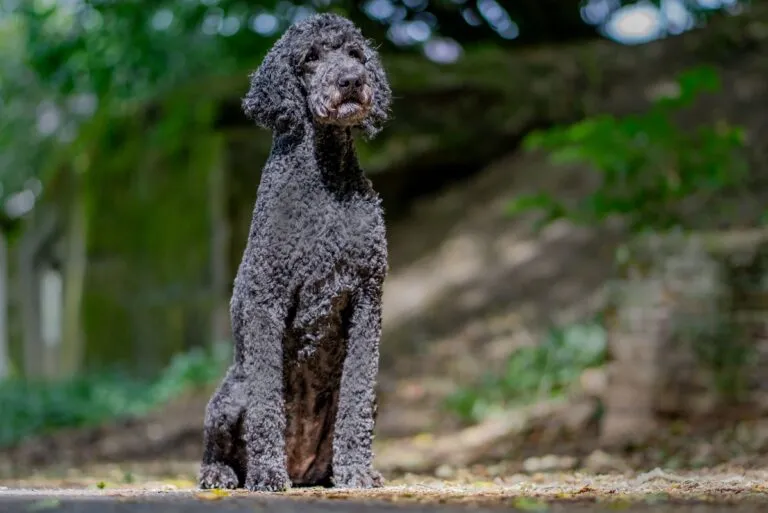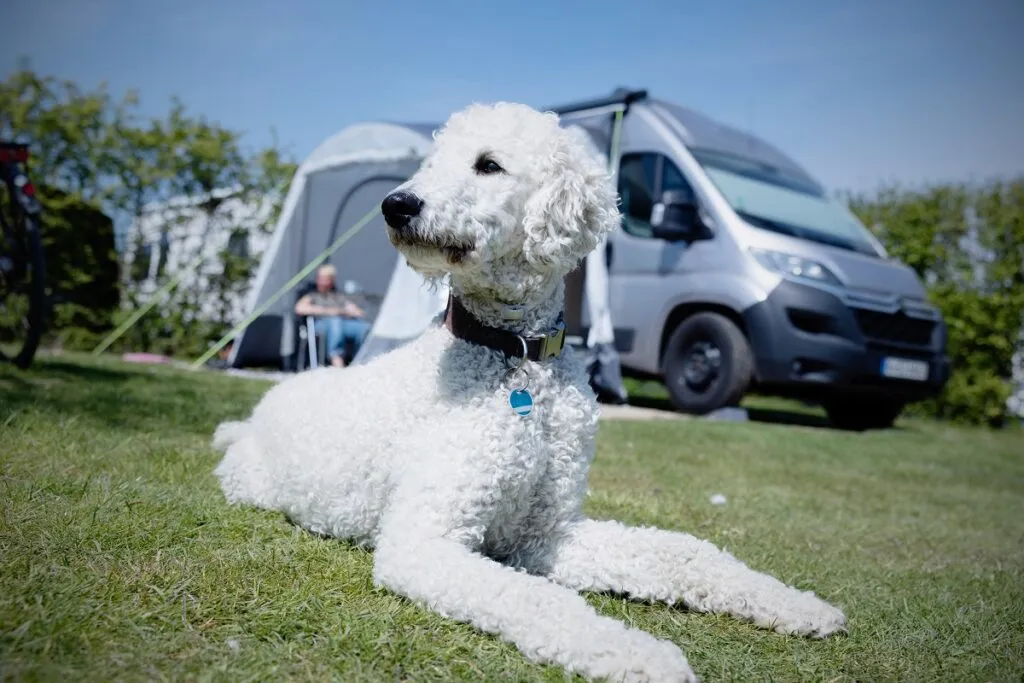Medium Size Poodle
Beneath its curly fur lies a true clown: the Standard Poodle, also known as the Royal Poodle, is a clever little character brimming with charm. Once a popular choice for duck hunting, today this friendly, intelligent four-legged friend cuddles with children and diligently serves as a therapy or guide dog.

© AnnKristin / stock.adobe.com
The Standard Poodle has evolved from its hunting dog roots into a beloved family companion and trusted assistance dog
The Standard Poodle is the largest variant of the Poodle breed, reaching a height at the withers of 45 to 60 centimeters, with an allowance of up to two additional centimeters within the tolerance range. They usually weigh between 18 and 30 kilograms.
Did you know? Other varieties of Poodles include Miniature Poodles, and Toy Poodles.
Royal Poodle is another common term for the Standard Poodle—it’s the same variant of Poodle. Standard Poodles have a slim, athletic build. Their snouts are strikingly narrow, with dark eyes set at a slight angle. The Royal Poodle is also characterised by its hanging ears and high-set tail.
The dense, soft coat of the Royal Poodle is curled and without an undercoat. The classic coat colours for this Poodle are white, black, and brown. However, there are also silver, apricot, and cream-coloured Standard Poodles, as well as bicolor ones in black-and-tan or harlequin.
The Standard Poodle differs from smaller breeding forms like the Mini or Toy Poodles by its calm, serene nature. Royal Poodles are lovable, balanced dogs that form strong bonds with their human families.
Since these kid-loving canines are friendly and enjoy playing, they are well-suited as family dogs. The vigilant animals also have a good protective instinct and often announce visitors with barking.
Singles can also find great joy in a loyal, cuddly Standard Poodle that accompanies them everywhere in daily life. By the way: many owners describe their Royal Poodle as a “clown” that constantly thinks up new mischief, ensuring plenty of fun and action.
For dog beginners, the Standard Poodle is quite suitable. The curly companion is generally easy to train and very eager to learn. However, like other dogs, it needs consistent training. Once the confident Royal Poodle has learned something wrong, it can be difficult to untrain the undesired behaviour.
 © bilderstoeckchen / stock.adobe.com
© bilderstoeckchen / stock.adobe.com
Originally, the Standard Poodle was kept as a hunting dog responsible for retrieving ducks from the water. And even today, a certain hunting instinct still lies dormant within this well-behaved companion dog. An anti-hunting training can therefore make sense for this Poodle variant.
The athletic, enduring dog needs sufficient exercise and must also be mentally stimulated. One to two hours of exercise per day are recommended. Demanding retrieving or agility games can be incorporated to make the walk more interesting. Due to their past as water dogs, many Standard Poodles also enjoy swimming.
The Royal Poodle is commonly considered one of the most intelligent dogs. It is very teachable and quickly learns new tricks. In the past, these dogs even performed acrobatic acts in circuses. Nowadays, the elegant, dignified animals are more likely seen at dog shows or on the dog sports field. They take great delight in activities such as Agility and Obedience.
Because of their intelligence and obedience, Standard Poodles are also well suited as assistance and service dogs. They can be trained, for instance, as guide dogs, search and rescue dogs, or therapy dogs.
Typical for the Standard Poodle is its wavy fur, which constantly grows. Since these dogs hardly shed, have no undercoat, and do not go through a moulting phase, they are generally considered allergy-friendly.
The fact that the Standard Poodle doesn’t shed doesn’t mean it doesn’t need coat care—quite the contrary. Its coat must be brushed several times a week to keep it free from knots and dirt.
Moreover, the fur of the Standard Poodle must be regularly trimmed or clipped at the dog salon. A visit to the dog groomer every six to eight weeks is required to prevent tangles.
The once-common lion cut is rarely seen today. With this style, the belly and the front and back legs are shaved, leaving voluminous pompons at the ankles. This type of Poodle cut was particularly fashionable in the 50s, 60s, and 70s, when the Standard Poodle became a fashionable accessory for refined ladies.
However, the distinctive lion cut originally had a practical purpose. It was designed to make swimming easier for hunting dogs. The fluffy fur at the ankle joints served as a kind of wrist warmer and was meant to protect against the cold.
The Standard Poodle requires a protein-rich diet but is otherwise undemanding about its food. Most Royal Poodles are not picky eaters and will eat both wet food and dry food, as well as raw food.
Healthy chewing snacks support the dog’s dental cleaning and can prevent gum inflammation.
The Standard Poodle is fundamentally a healthy, robust dog. However, this Poodle form can be prone to certain hereditary eye diseases. These include Progressive Retinal Atrophy (PRA), which can lead to blindness. Like other large dog breeds, the Royal Poodle also tends to develop hip dysplasia.
In addition, Royal Poodles can develop cardiovascular diseases such as dilated cardiomyopathy. In this condition, the heart muscle is abnormally enlarged, which can lead to heart failure. Other typical Standard Poodle diseases include adrenal insufficiency (Addison’s disease), epilepsy, and von Willebrand’s Disease, a blood clotting disorder.
With good care, Royal Poodles can live to be 12 to 15 years old.
Plenty of exercise, a species-appropriate diet, careful coat care, and regular visits to the vet contribute significantly to the health of this active dog.
Whether the ancestors of the Standard Poodle came from Germany or France is debated. The name “Poodle” by the way, comes from the old German word “puddeln,” meaning “to splash in the water”—a nod to its past as a duck hunter.
From the “beautiful Poodle,” first mentioned in writing in 1555, later came the breeding forms of the Standard, Miniature, Toy, and Teacup Poodles. During the 19th century, the Standard Poodle made its transition from a working dog to a companion dog. Initially, the friendly canine was especially popular with the aristocracy. Later, it also moved into middle-class homes.
Crossbreeding with Spaniels resulted in the typical woolly-soft Poodle fur. After World War II, the canine umbrella association Fédération Cynologique Internationale (FCI) designated France as the Standard Poodle’s country of origin. Breed standards were also defined for breeding.
If the puppy has an impressive pedigree—with parents, for example, who have been successful at dog shows—the purchase price can be even higher.
Good to know: A healthy puppy has clear eyes and a clean, shiny coat. It should be chipped, vaccinated, and dewormed at the time of handover and come with all the necessary papers.
An alternative to buying from a breeder is to visit an animal shelter. There, various four-legged friends are looking for new homes—including often breed dogs.
There are also animal welfare organisations dedicated to the rehoming of Standard Poodles. Adopting a fully grown, well-trained Royal Poodle not only relieves the animal rescuers but also saves the new owner a lot of training work. Conclusion: Charming Family Dogs
Royal Poodles still have the reputation of being artfully groomed accessories for refined ladies. To maintain this stereotype does a disservice not only to the loveable canines but also to their owners. After all, Standard Poodles are extremely intelligent, teachable, and people-oriented animals that can greatly enrich family life. Profile of the Standard Poodle (Royal Poodle)
| Special Features: | Intelligent family dog, often suitable for allergy sufferers |
| Character: | Friendly, active, vigilant, balanced |
| Height at the Withers: | Males: 45-60 cm; Females: 45-60 cm |
| Weight: | Males: up to 30 kg; Females: up to 25 kg |
| Fur: | Curly, without undercoat, primarily in Black, White, Brown, Apricot, Cream, Silver |
| Coat Care: | Brush several times weekly, regular trimming at the dog salon, doesn’t shed |
| Exercise: | High need for exercise, dog sports, retrieving |
| Suitable for Beginners: | Yes |
| Barking: | Vigilant, announces visitors with barking |
| Life Expectancy: | 12-15 years |
| Typical Diseases: | Hip dysplasia, progressive retinal atrophy (PRA), epilepsy, Addison’s disease |
| FCI Group: | Group 9: Companion and Toy Dogs Section 2: Poodles |
| Origin: | France (or Germany) |
Fans of the Bearded Collie agree that those who aren't familiar with this dog breed simply have to get acquainted with it. And those who have experienced how a Bearded Collie bolts across meadows with its flowing fur, how it rolls around full of energy and joy and how it attentively and observantly takes into account its owners wishes become simply addicted to this original dog breed and its unique charm.
The Goldendoodle isn't a breed, but a pairing between Golden Retrievers and Medium or Standard Poodles. Marketed as a low-maintenance dog for allergy sufferers, this hybrid is enjoying increasing popularity amongst dog lovers, similar to the Labradoodle.